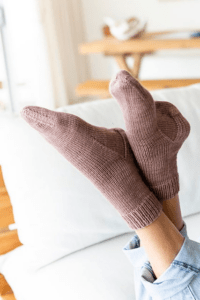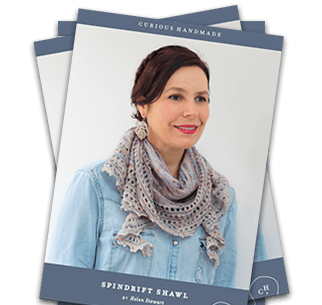Today I’m really happy to share another guest post from my wonderful Curious Handmade Wardrobe Challenge collaborator, Susan (aka Kizmet on Ravelry.) When you start talking about creating a mindful wardrobe, you run into a huge amount of terms and trends. Susan has been courageously exploring them for us, and today she takes on what may be the most revered notion of all: the capsule wardrobe. It’s something I’ve been interested in for ages, and this post is packed with so much great information. Susan will be joining me on the podcast tomorrow, so be sure to drop in for even more handmade wardrobe goodness!
*****

When I started to explore the idea of a creating a thoughtful wardrobe with a focus on “handmade wardrobe”-I came across a couple of terms frequently. I wrote earlier about one of them-the uniform. Smartly, I chose the easier concept first.
The other term that comes up even more frequently is the Capsule Wardrobe.
Here’s the Wikipedia definition:
Capsule wardrobe is a term coined by Susie Faux, the owner of a London boutique called “Wardrobe” in the 1970s. According to Faux, a capsule wardrobe is a collection of a few essential items of clothing that don’t go out of fashion, such as skirts, trousers, and coats, which can then be augmented with seasonal pieces. This idea was popularized by American designer Donna Karan, who, in 1985, released an influential capsule collection of seven interchangeable work-wear pieces.
You can find scores of information and resources on capsule wardrobes–on YouTube, in blogs, ebooks and on Pinterest.
At the highest level, I think the idea of a capsule wardrobe is as tool for achieving a rational vs impulsive approach to acquiring and wearing clothes. I’d like to be more deliberate in my choices–particularly about wearables what to make. Making for me is more time-intensive than shopping, and in some cases more expensive, albeit with better materials and an end-product that is unique.
Will the capsule approach help me in this journey?
I’ll provide some examples of capsule wardrobes, my analysis of them, a brief list of capsule wardrobe methods and a couple of in-depth methods of how to do it. And if you’ve stuck with me that far, I’ll provide a bit of color–commentary on my experience with the process.
Pinterest is probably the easiest way to find examples. I gathered a number of them–you can see my collection here. I analyzed the capsules I collected into Tops (things you’d wear on top that don’t require anything else on top), Bottoms (pants/shorts and skirts), Jackets (tops that really require you to wear another top under them), Dresses, and then Shoes and Accessories.
|
Tops |
Pants |
Skirts |
Jackets |
Dresses |
Shoes |
Accss |
Total |
|
|
5 |
2 |
2 |
1 |
1 |
2 |
13 |
||
|
6 |
3 |
2 |
1 |
2 |
5 |
19 |
||
|
4 |
2 |
1 |
2 |
3 |
12 |
|||
|
7 |
2 |
1 |
1 |
1 |
3 |
2 |
17 |
|
|
4 |
3 |
2 |
9 |
|||||
|
15 |
7 |
2 |
2 |
4 |
3 |
33 |
||
|
4 |
2 |
2 |
1 |
9 |
||||
|
5 |
2 |
2 |
2 |
1 |
3 |
2 |
17 |
|
|
4 |
2 |
2 |
1 |
1 |
2 |
1 |
13 |
|
|
4 |
2 |
2 |
8 |
|||||
|
4 |
2 |
1 |
2 |
2 |
4 |
15 |
||
|
6 |
2 |
2 |
3 |
3 |
1 |
6 |
23 |
As you can see, the number of pieces varies overall with the size of the capsule. What I learned from this analysis is that they all have more top pieces than bottoms. Obvious perhaps, but still good to know. My other observation is more visual than mathematical: they all appeared cohesive to me with a very high mix-and-match factor, but consequently, the outfits were a bit similar due to that cohesiveness.
For capsule methods, Carrie LeighAnna’s YouTube video Which Capsule Wardrobe is Right for You, gives a really nice overview of a few of the common approaches:
-
The No-Brainer Wardrobe by Hayley Morgan. There’s the ebook on Amazon for $7.99 and the workshop (ebook plus videos and more) for $29.
-
Project 333: 33 items that you wear for each 3 month period of time.
-
The Dozen Formula: sadly the links for this no longer work-but Carrie described the concept. 4 bottoms, 4 jackets, 4 blouses. That’s it. I find it quite appealing.
For each of these you can find lots of resources online. But there’s even more in the form of in-depth “how-to” instructions. These are instructions aimed at helping your overhaul or design a big and broad approach to your wardrobe, rather than focusing on the capsule solution.
-
Wardrobe Architect: this is a free, 12 week program offered by Colette.
-
The Personal Style and Perfect Wardrobe Workbook by Anuschka of Into Mind: this is a paid ($22) e-book with a 17 step program. But she also has a lot of good, free content on her site as well. The Quick Fix for Busy People a is very approachable and has an example of a PhD student who works in a casual office and wants to overhaul her “everyday wear.”
Comparisons of the steps in these 2 how-to processes:
|
Into Mind ($22) |
Wardrobe Architect (free) |
|
Dissect your Current Wardrobe |
Making Style More Personal |
|
Identify Style preferences |
Defining a Core Style |
|
Analyze Lifestyle |
Exploring Shapes |
|
Color Palette |
Building Silhouettes |
|
Select Key Proportions |
Your Color Story |
|
Map out your style concept |
Organizing your Palette |
|
Develop a signature look |
Exploring solids and prints |
|
Work out a basic wardrobe structure |
Hair, Makeup and Beauty |
|
Build your capsule wardrobe |
The Capsule Wardrobe |
|
Inventory your wardrobe |
The Capsule Palette |
|
Write a helpful shopping list |
Planning your pieces |
|
Explore fit and fabric preferences |
Adding Accessories |
|
Write a brand guide for your style |
(bonus) Overcoming Editing Hurdles |
|
Discover new item combinations |
|
|
Style 10 perfect outfits |
|
|
Build a travel wardrobe |
|
|
Upgrade your wardrobe organization |
I found across Into Mind first and have been working my way through it.
I’ve gotten quite a bit out of some chapters:
-
Sorting my closet into what I love, what I don’t and then analyzing why to identify themes
-
Collecting shapes or silhouettes, analyzing them to see what realistically would work for me in terms of lifestyle and how they look on me. This one actually had me “hacking” my current clothes into pinned shapes of the silhouettes I was attracted to, as well as going to RTW (ready to wear) shops and trying on some new shapes.
But I’ve gotten stuck in the middle where all of these themes, shapes, colors, looks, etc. are supposed to come together. I’d like more examples, or a support group, or some images of women who are older, rounder and comfortable with being older and rounder making this concept work.
So in the end (or in the middle, which is where I’d describe myself in this journey)–did the capsule approach help me?
I haven’t given up on my goals of having a wardrobe with more handmade items that go well together and that I wear for most of the days I’m working at home or out and about in the world with friends. The process helped me hone down which part of my wardrobe (work vs casual vs workout, etc.) I’m focusing on. Analyzing what I have that makes me feel the way I want to vs not-liking, and then looking at other sources of inspiration online, etc. has helped me identify the look I want. I’ve learned I don’t really want a closet of clothes where everything goes with everything else–that’s just too structured and too cohesive for me.
- I’ve learned that my style is comfortable, casual, pulled-together and pretty.
- I’ve identified my colors as gray, black, dark purple, pink, denim and near-white.
- Rather than having a everything-goes-with-everything-else, I want 2-3 silhouettes, with a few mix and match items within each silhouette, and a couple of outfits that are off the grid for when I don’t want to look like I’m wearing another version of the same.
The 3 silhouettes that I’m pursuing these days: t-shirts with jean/shorts (with a cardigan or a shawl), tunics with leggings, and skirts with tops. Using the dozen formula concept I’d have “4” of each piece for each silhouette.
|
Silhouette |
Tops (#) |
Bottoms (#) |
Other |
|
T-shirts and Jeans |
2 plain t-shirts 2 pretty-flowy t-shirts |
1 jean 1 capri denim 2 shorts |
Shawls-I have dozens |
|
Tunics and leggings |
Grey leggings Black leggings Denim leggings |
4 tunics |
Short cardi AC bolero |
|
Skirts and tops |
4 tops (these can overlap with the tops I also wear with jeans) |
2 A-line knee length skirts in solids 1 floral skirt I below-knee skirt |
2 “waterflow” cardigans Miscellaneous shawls |
I think by approaching it this way I have identified the missing pieces I want to make. And on any given day, I’d be able to choose which silhouette fits my day’s schedule and my mood, and then which of the options in that silhouette are calling me (and are clean.)
For the moment, this is enough for me, perhaps even a bit more than enough. It’s great to know that there are many people in the world way more dedicated to this endeavor than I am–they will provide endless inspiration anytime I want to go get some more!



